SECTION 6 CHEVROLET AVALANCHE 2002 1.G Owners Manual
[x] Cancel search | Manufacturer: CHEVROLET, Model Year: 2002, Model line: AVALANCHE, Model: CHEVROLET AVALANCHE 2002 1.GPages: 437, PDF Size: 3.28 MB
Page 4 of 437

Table of Contents
Windows
Keys and Door Locks
Keyless Entry System
Liftgate
Automatic Transmission Operation
Four-Wheel Drive
Parking Brake
Tilt Wheel
Turn Signal/Multifunction Lever
Windshield WipersCruise Control
Exterior and Interior Lamps
Mirrors
Storage Compartments
Convenience Net
Accessory Power Outlets
OnStar® System (If Equipped)
Sunroof (If Equipped)
HomeLink® Transmitter (If Equipped)
Instrument Panel, Warning Lights and Gages Seats and Seat Controls
Safety BeltsAir Bag Systems
Restraint Systems for Children
Section
1
Section
2
Seats and Restraint Systems
Features and Controls
ii
Page 5 of 437
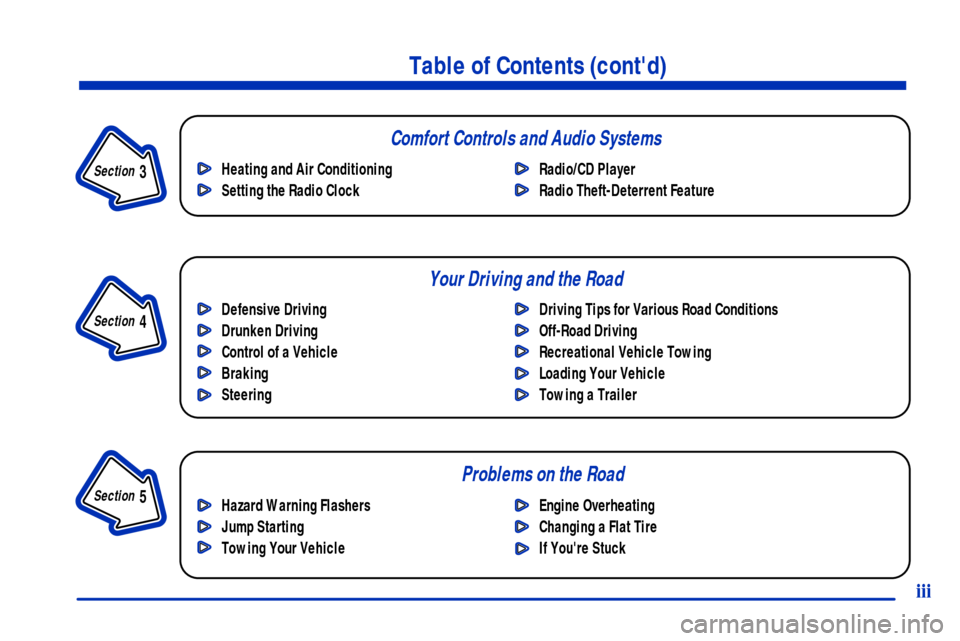
Comfort Controls and Audio Systems
Your Driving and the Road
Table of Contents (cont'd)
Defensive Driving
Drunken Driving
Control of a Vehicle
Braking
SteeringDriving Tips for Various Road Conditions
Off-Road Driving
Recreational Vehicle Towing
Loading Your Vehicle
Towing a Trailer Heating and Air Conditioning
Setting the Radio ClockRadio/CD Player
Radio Theft-Deterrent Feature
Hazard Warning Flashers
Jump Starting
Towing Your VehicleEngine Overheating
Changing a Flat Tire
If You're Stuck
Problems on the Road
iii
Section
5
Section
4
Section
3
Page 6 of 437
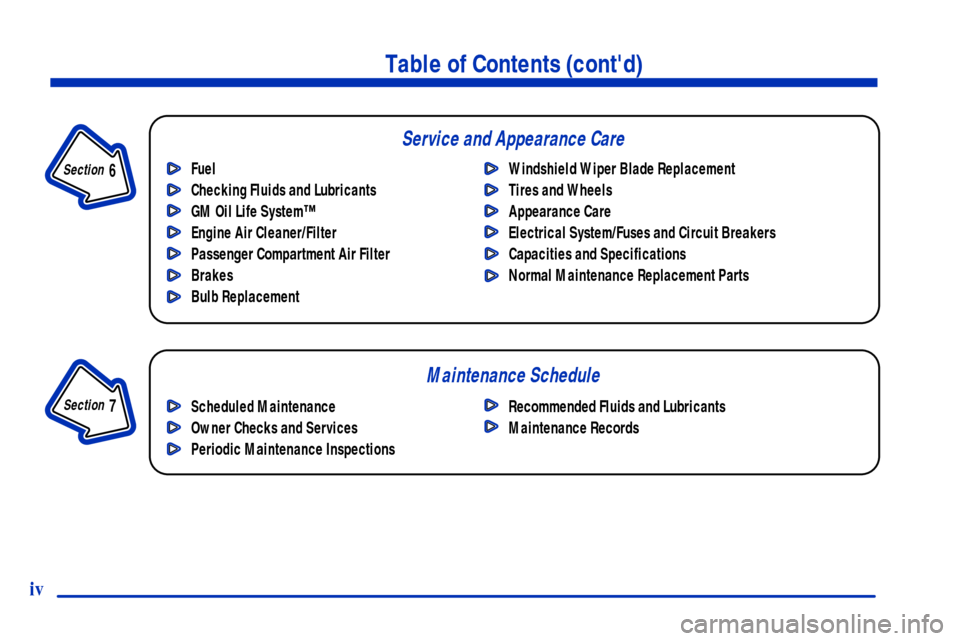
iv
Table of Contents (cont'd)
Maintenance Schedule Service and Appearance Care
Section
7
Section
6
Scheduled Maintenance
Owner Checks and Services
Periodic Maintenance InspectionsRecommended Fluids and Lubricants
Maintenance Records Windshield Wiper Blade Replacement
Tires and Wheels
Appearance Care
Electrical System/Fuses and Circuit Breakers
Capacities and Specifications
Normal Maintenance Replacement Parts Fuel
Checking Fluids and Lubricants
GM Oil Life System™
Engine Air Cleaner/Filter
Passenger Compartment Air Filter
Brakes
Bulb Replacement
Page 7 of 437
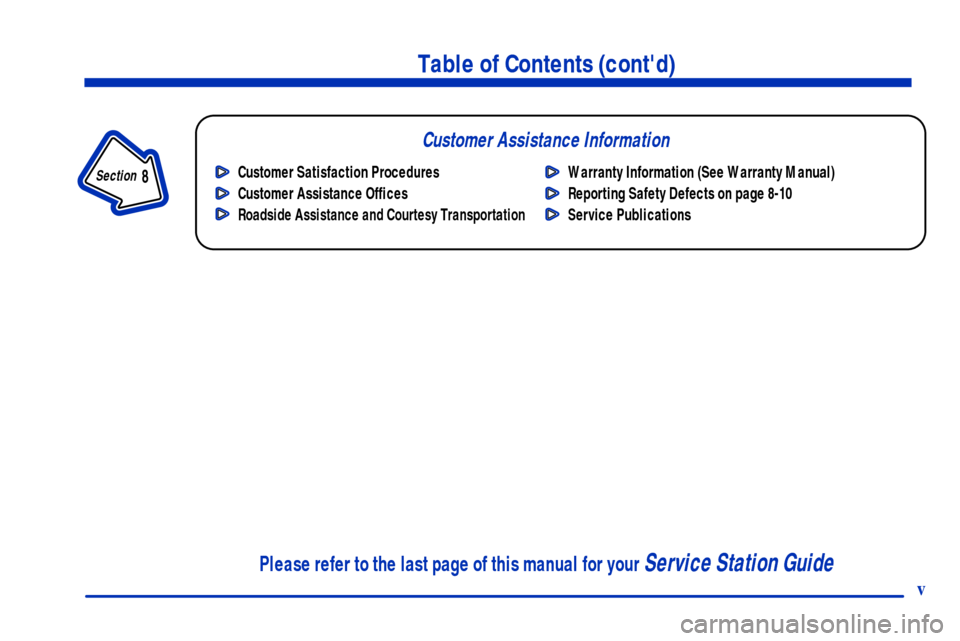
Table of Contents (cont'd)
Customer Assistance Information
In the Index you will find an alphabetical listing of almost every subject in this manual.
You can use it to quickly find something you want to read.
Section
8Customer Satisfaction Procedures
Customer Assistance Offices
Roadside Assistance and Courtesy Transportation
Warranty Information (See Warranty Manual)
Reporting Safety Defects on page 8-10
Service Publications
Index
Section
9
Please refer to the last page of this manual for your Service Station Guide
v
Page 12 of 437

Service Station Guide
For
a More
Detailed Look at
What's Under the Hood
See Section 6
Cooling System
See Section 5
Spare Tire Pressure
See Section 6
Tire Pressure
See Section 6
Fuel
Use unleaded only.
See Section 6
for octane ratings.
Oil Viscosity
Engine Oil
See Section 6
Engine Oil Dipstick
See Section 6
Hood Release
See Section 6
Windshield Washer
Fluid
See Section 6Battery
See Section 6
Page 13 of 437
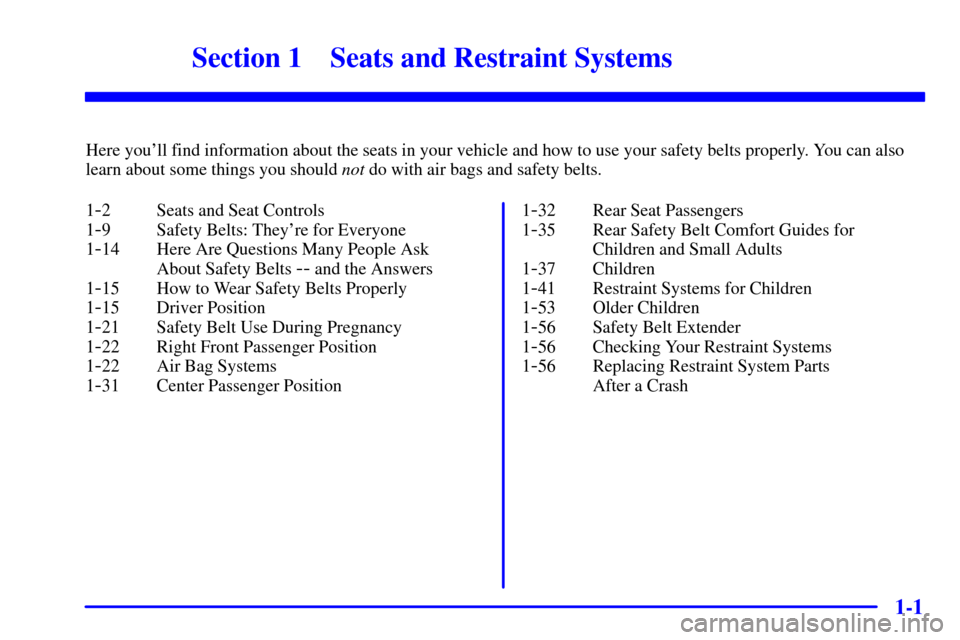
1-
1-1
Section 1 Seats and Restraint Systems
Here you'll find information about the seats in your vehicle and how to use your safety belts properly. You can also
learn about some things you should not do with air bags and safety belts.
1
-2 Seats and Seat Controls
1
-9 Safety Belts: They're for Everyone
1
-14 Here Are Questions Many People Ask
About Safety Belts
-- and the Answers
1
-15 How to Wear Safety Belts Properly
1
-15 Driver Position
1
-21 Safety Belt Use During Pregnancy
1
-22 Right Front Passenger Position
1
-22 Air Bag Systems
1
-31 Center Passenger Position1
-32 Rear Seat Passengers
1
-35 Rear Safety Belt Comfort Guides for
Children and Small Adults
1
-37 Children
1
-41 Restraint Systems for Children
1
-53 Older Children
1
-56 Safety Belt Extender
1
-56 Checking Your Restraint Systems
1
-56 Replacing Restraint System Parts
After a Crash
Page 27 of 437
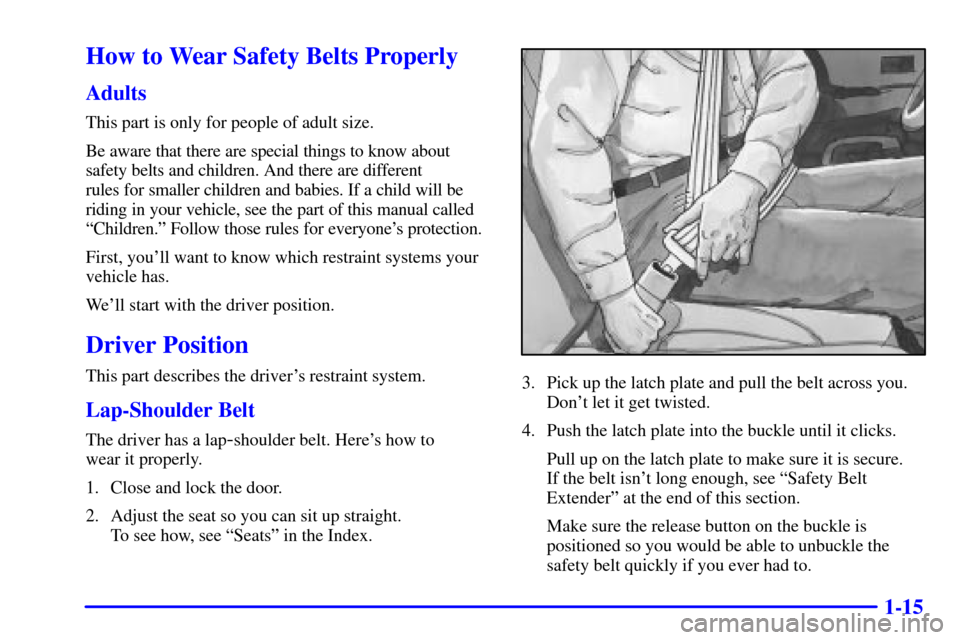
1-15
How to Wear Safety Belts Properly
Adults
This part is only for people of adult size.
Be aware that there are special things to know about
safety belts and children. And there are different
rules for smaller children and babies. If a child will be
riding in your vehicle, see the part of this manual called
ªChildren.º Follow those rules for everyone's protection.
First, you'll want to know which restraint systems your
vehicle has.
We'll start with the driver position.
Driver Position
This part describes the driver's restraint system.
Lap-Shoulder Belt
The driver has a lap-shoulder belt. Here's how to
wear it properly.
1. Close and lock the door.
2. Adjust the seat so you can sit up straight.
To see how, see ªSeatsº in the Index.
3. Pick up the latch plate and pull the belt across you.
Don't let it get twisted.
4. Push the latch plate into the buckle until it clicks.
Pull up on the latch plate to make sure it is secure.
If the belt isn't long enough, see ªSafety Belt
Extenderº at the end of this section.
Make sure the release button on the buckle is
positioned so you would be able to unbuckle the
safety belt quickly if you ever had to.
Page 34 of 437

1-22
The best way to protect the fetus is to protect the
mother. When a safety belt is worn properly, it's
more likely that the fetus won't be hurt in a crash.
For pregnant women, as for anyone, the key to
making safety belts effective is wearing them properly.
Right Front Passenger Position
To learn how to wear the right front passenger's safety
belt properly, see ªDriver Positionº earlier in this section.
The right front passenger's safety belt works the same
way as the driver's safety belt
-- except for one thing.
If you ever pull the shoulder portion of the belt out
all the way, you will engage the child restraint locking
feature. If this happens, just let the belt go back all the
way and start again.
Air Bag Systems
This part explains the frontal and side impact air
bag systems.
Your vehicle has four air bags
-- a frontal air bag
for the driver, another frontal air bag for the right front
passenger, a side impact air bag for the driver, and
another side impact air bag for the right front passenger.Frontal air bags are designed to help reduce the risk
of injury from the force of an inflating frontal air bag.
But these air bags must inflate very quickly to do their
job and comply with federal regulations.
Here are the most important things to know about the
air bag systems:
CAUTION:
You can be severely injured or killed in a crash
if you aren't wearing your safety belt
-- even if
you have air bags. Wearing your safety belt
during a crash helps reduce your chance of
hitting things inside the vehicle or being ejected
from it. Air bags are designed to work with safety
belts but don't replace them.
Frontal air bags for the driver and right front
passenger are designed to work only in moderate
to severe crashes where the front of your vehicle
hits something.
CAUTION: (Continued)
Page 44 of 437
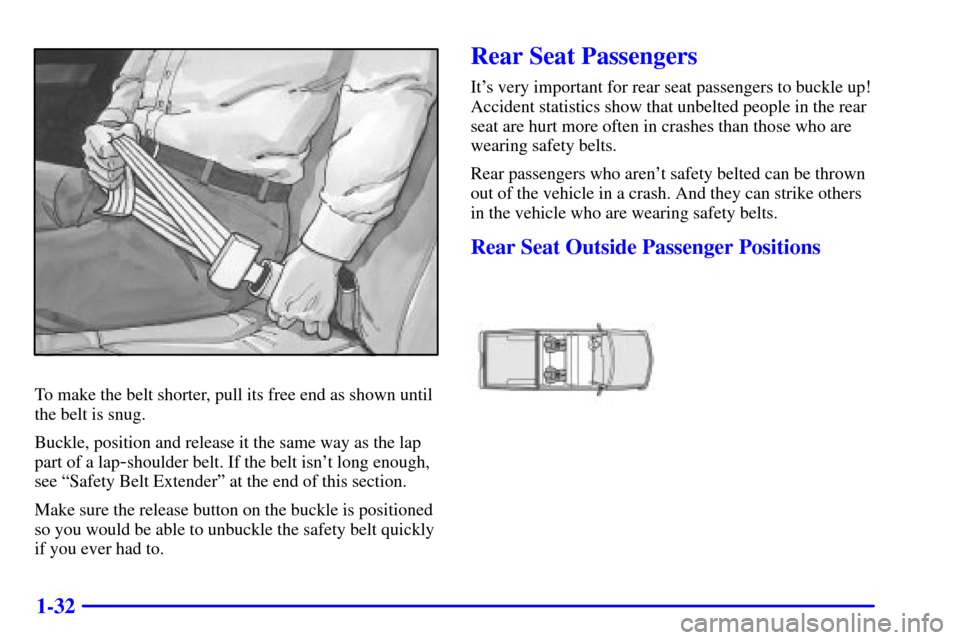
1-32
To make the belt shorter, pull its free end as shown until
the belt is snug.
Buckle, position and release it the same way as the lap
part of a lap
-shoulder belt. If the belt isn't long enough,
see ªSafety Belt Extenderº at the end of this section.
Make sure the release button on the buckle is positioned
so you would be able to unbuckle the safety belt quickly
if you ever had to.
Rear Seat Passengers
It's very important for rear seat passengers to buckle up!
Accident statistics show that unbelted people in the rear
seat are hurt more often in crashes than those who are
wearing safety belts.
Rear passengers who aren't safety belted can be thrown
out of the vehicle in a crash. And they can strike others
in the vehicle who are wearing safety belts.
Rear Seat Outside Passenger Positions
Page 45 of 437
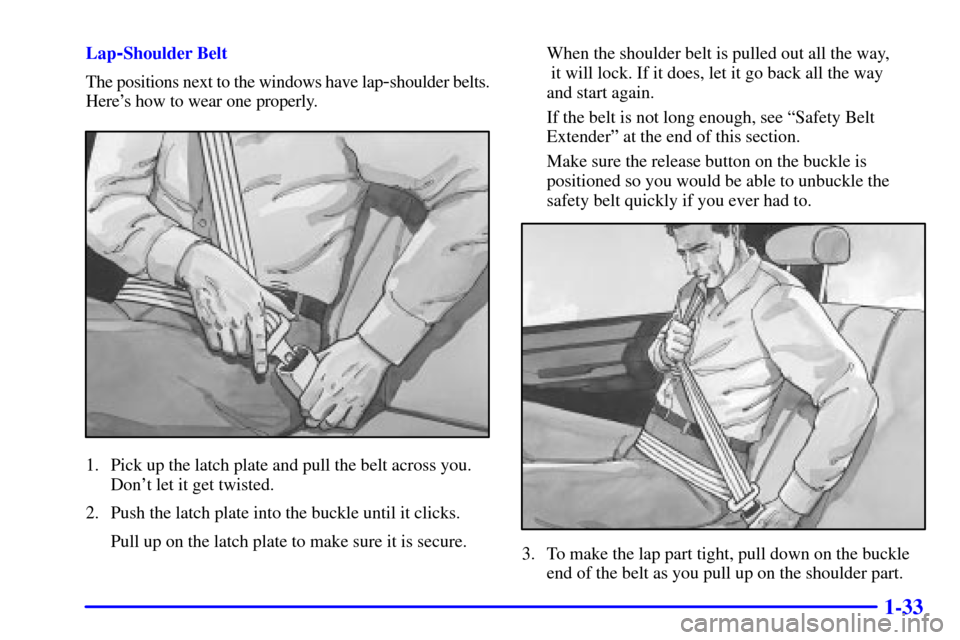
1-33
Lap-Shoulder Belt
The positions next to the windows have lap
-shoulder belts.
Here's how to wear one properly.
1. Pick up the latch plate and pull the belt across you.
Don't let it get twisted.
2. Push the latch plate into the buckle until it clicks.
Pull up on the latch plate to make sure it is secure.When the shoulder belt is pulled out all the way,
it will lock. If it does, let it go back all the way
and start again.
If the belt is not long enough, see ªSafety Belt
Extenderº at the end of this section.
Make sure the release button on the buckle is
positioned so you would be able to unbuckle the
safety belt quickly if you ever had to.
3. To make the lap part tight, pull down on the buckle
end of the belt as you pull up on the shoulder part.